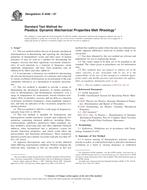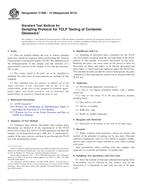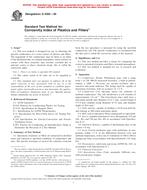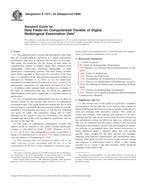ASTM D4440-07
- Standard Test Method for Plastics: Dynamic Mechanical Properties: Melt Rheology
- standard by ASTM International, 03/01/2007
- Publisher: ASTM
$23.00$46.80
1.1 This test method outlines the use of dynamic mechanical instrumentation in determining and reporting the rheological properties of thermoplastic resins and other types of molten polymers. It may be used as a method for determining the complex viscosity and other significant viscoelastic characteristics of such materials as a function of frequency, strain amplitude, temperature, and time. Such properties may be influenced by fillers and other additives.
1.2 It incorporates a laboratory test method for determining the relevant rheological properties of a polymer melt subjected to various oscillatory deformations on an instrument of the type commonly referred to as a mechanical or dynamic spectrometer.
1.3 This test method is intended to provide a means of determining the rheological properties of molten polymers, such as thermoplastics and thermoplastic elastomers over a range of temperatures by nonresonant, forced-vibration techniques. Plots of modulus, viscosity, and tan delta as a function of dynamic oscillation (frequency), strain amplitude, temperature, and time are indicative of the viscoelastic properties of a molten polymer.
1.4 This test method is valid for a wide range of frequencies, typically from 0.01 to 100 Hz.
1.5 This test method is intended for homogenous and heterogeneous molten polymeric systems and composite formulations containing chemical additives, including fillers, reinforcements, stabilizers, plasticizers, flame retardants, impact modifiers, processing aids, and other important chemical additives often incorporated into a polymeric system for specific functional properties, and which could affect the processability and functional performance. These polymeric material systems have molten viscosities typically less than 106 Pas (107 poise).
1.6 Apparent discrepancies may arise in results obtained under differing experimental conditions. Without changing the observed data, reporting in full (as described in this test method) the conditions under which the data was obtained may enable apparent differences observed in another study to be reconciled.
1.7 Test data obtained by this test method are relevant and appropriate for use in engineering design.
1.8 The values stated in SI units are to be regarded as the standard. The values given in parentheses are for information only.
This standard does not purport to address all of the safety concerns, if any, associated with its use. It is the responsibility of the user of this standard to establish appropriate safety and health practices and determine the applicability of regulatory limitations prior to use.
Note 1This test method is equivalent to ISO 6721, Part 10.
Related Products
ASTM C1606-10(2014)
Standard Test Method for Sampling Protocol for TCLP Testing of Container Glassware..
$20.00 $39.00
ASTM D3111-99(2004)e1
Standard Test Method for Flexibility Determination of Hot-Melt Adhesives by Mandrel Bend Test Method..
$23.00 $46.80
ASTM E1475-02(2008)
Standard Guide for Data Fields for Computerized Transfer of Digital Radiological Examination Data..
$26.00 $52.80





